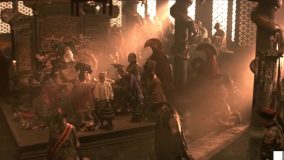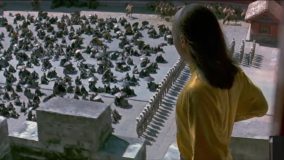THE LAST EMPEROR, DIR. BERNARDO BERTOLUCCI (1987)
The Forbidden City, Dongcheng District, Beijing

Pu Yi and his brother were running at the Tianhedian Square in front of the Hall of Supreme Harmony while a long line of eunuchs and attendants was chasing after them for protection. Scenes from The Last Emperor 1987, directed by Bernardo Bertolucci.
The Last Emperor is a historical epic film recording the whole life of Aisin Juero Pu Yi, who was the last imperial ruler of China. It has two timelines in the form of half flashbacks and half inserts to unfold Pu Yi’s life from a toddler monarch in the Forbidden City (1908-1924) to a puppet emperor in Manchukuo Palace (1934-1945), a prisoner in Fu Shun War Criminals Prison (1949-1959), then an ordinary civilian (1950-1967) who had witnessed many aspects of modern Chinese history.
As the imperial palace where Pu Yi spent 1/3 of his lifetime, the Forbidden City, exemplifying the traditional Chinese palatial architecture, plays an essential role in narrating Pu Yi’s life as an emperor. Meanwhile, the film was the first feature film permitted to be filmed inside the Forbidden City. Thus, the Forbidden City as a plot is also to be understood as an urban gaze and a spectator from global.
When Pu Yi was three-year-old, he was summoned to the Forbidden City and declared an emperor. Since then, he was locked in his palace and cut off news from the outside. The complex consists of 980 buildings, encompassing 8,886 rooms and covering 720,000 square meters, which acts as a natural obstacle for Pu Yi to explore the outside world. Every time he tried to escape, the guard and attendants would catch him. This gorgeous and enormous place was the symbol of opulence and power where ordinary people had no chance to come in, while it also became the tangible cage of Pu Yi. Back today, its position as the ceremonial and political center for over 500 years has disappeared. Instead, it was declared a World Heritage Site in 1987 and became a landmark of China with extensive collections of artwork and artifacts, innovative culture output, and an emerging tourist market under the charge of the Palace Museum.
As Ackbar Abbas said, “Space is both socially produced and produces the social”.1 The social identity of the Forbidden City is built for the emperor’s residence with heaven worship while it indeed closed the gate to divide different classes between royalty and citizens. From Pu Yi’s side, when he entered the Forbidden City first time, it was only a room with dark and dim light. As he was growing up, there was more light coming in with a clearer overview of the Forbidden City. Gradually, the Forbidden City shaped his feeling of power and desire to rule the country. In the meantime, the Forbidden City was operated by Pu Yi, expelling all the eunuchs, and then he was ordered to leave. Considering the Forbidden City in a global context, it is not only a setting to position us as insiders but also a plot to make us outsiders. The film implements lots of long takes to show us the Forbidden City slowly, from Pu Yi’s first arrival, his brother’s first visit, his tutor (Johnston) ‘s first arrival, etc. As audiences with little knowledge of the Forbidden City, we were settled into an insider’s experience of what Edward Relph calls “vicarious insideness.”2
— Shiqing Li 3035772456


- Left: The first time Pu Yi entered the Forbidden City and met the Empress Dowager Ci Xi. Scenes from The Last Emperor 1987, directed by Bernardo Bertolucci. Right: The Meridian Gate between the Forbidden City and the public was closed. Scenes from The Last Emperor 1987, directed by Bernardo Bertolucci.


Left: Pu Yi commanded to expel all the eunuchs out of the palace. They were waiting for their belongings at Tian’anmen Square out of the Forbidden City. Scenes from The Last Emperor 1987, directed by Bernardo Bertolucci. Right: After Pu Yi got his first bike, he headed to the Meridian Gate and wanted to go outside. Scenes from The Last Emperor 1987, directed by Bernardo Bertolucci.
Notes:
1 Ackbar Abbas, “2 Between the Visible and Intelligible in Asian Cinema.” Asian Cinema and the Use of Space: Interdisciplinary Perspectives (2015): 19.
2 Edward Relph, Place and placelessness (London: Pion, 1976), 51-55.
There is an in-depth reflection on the Forbidden City’s role in The Last Emperor. It is fantastic that you incorporated the theories of voyeurism and spatial production into your analysis. However, I wonder how you conducted your fieldwork since all the images are from the film. I would suggest more images of the real Forbidden City to make a comparative spatial analysis between the movie and reality. This will better integrate your fieldwork with film review by telling the different performances of the Forbidden City in the real and reel world respectively.